
Travelers might find themselves caught up in hazy weather both at domestic and international tourism destinations, and are advised to take precautions. (Photo: GT/Li Hao)
When Tang Xiaoliu, 32, finally arrived at the hallowed Taj Mahal in Uttar Pradesh, India, he found his view of the magisterial mausoleum obscured by a thick shroud of smog.
"I couldn't see the Taj Mahal," said Tang, a teacher, photographer and travel author from Shanghai. "I had to walk really close to feel her, by touching her with my hands. Visibility was less than 50 meters."
As outbound tourism from the Chinese mainland has skyrocketed in recent years, with more than 98 million people venturing abroad in 2013, according to the National Tourism Administration, travelers like Tang are discovering that China is not the only country enveloped in haze.
According to the World Health Organization (WHO), half of the world's urban population live in places where harmful fine particulate matter in the air is at least 2.5 times above the agency's recommended levels.
Globally, few of the 1,600 cities spread across 91 countries monitored by the WHO meet the air quality guideline levels of PM10, with cities in the Eastern Mediterranean and South-East Asia worst affected. The countries that fare best based on their index are generally high-income.
It is widely thought that China's air pollution problem is one of the factors that have led to a decrease in inbound tourism. This opinion was expressed in comments made by Dai Bin, director of China Tourism Academy, in a Xinhua News Agency report last year.
"However, due to a lack of statistical data in this area, we can't determine precisely how great the impact is," said Li Mingde, vice president of the Beijing Tourism Society.
Health risks
In March, local Thai newspaper The Nation reported that due to the high concentration of dust particles in the northern region of Chiang Mai, half of the number of tourists who had made plans to visit during the month had cancelled or postponed their trips, leading to a loss of $60.8 million in projected income.
Ma Jun, director of Beijing-based NGO Institute of Public and Environmental Affairs, advised travelers to be aware that there are different types of air pollution in different regions and countries, and that it could harm people in different ways.
"Smog in some regions contains more particles, such as in desert areas in North Africa and the Arab peninsula, where air quality is greatly affected by the sandy seasons," said Ma. "In areas that are undergoing industrialization and urbanization, such as the major cities in India and Iran, air quality can be especially bad."
Learning about the characteristics of types of air pollution people might encounter in the destination they are traveling to can help tourists to protect themselves, he said.
"Smog that mainly contains particles with comparatively simple characteristics is less harmful than smog that contains industrial waste gas or air from burnt garbage," he said. "[And] photochemical smog caused by a chemical reaction between the sunlight and auto emissions is much more harmful."
Ma said humidity also affected how harmful the haze in a city is, with higher humidity potentially leading to reactions that create more pathogens in the air particles. Zhang Lishan, head of the respiratory department at Dongzhimen Hospital in Beijing, agreed that different kinds of air pollution can cause different health problems. "Smog usually contains more than one kind of pollutant," said Zhang. "Theoretically, due to a large amount of outdoor activities, fatigue caused by traveling and the challenge of adapting to a new environment, [travelers] are under a higher risk of getting respiratory diseases compared to local residents."
Other factors that meant travelers were more susceptible to the threats of poor air, said Zhang, included keeping an irregular timetable and a weakened immune system while traveling.
He said that travelers commonly suffer from pharyngitis, bronchitis and upper respiratory tract infections. Those with chronic or preexisting respiratory problems could have their conditions exacerbated by being in a different environment, whether it be from the smog, local pollen or differences in temperature and climate, so it was important to take precautions.
















































